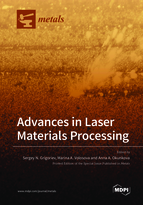Advances in Laser Materials Processing
A special issue of Metals (ISSN 2075-4701). This special issue belongs to the section "Additive Manufacturing".
Deadline for manuscript submissions: closed (31 December 2021) | Viewed by 30829
Special Issue Editors
Interests: processing by concentrated energy flows; laser processing; electrophysical machining; heat and hardening treatment; surface finishing and coating; powder metallurgy; nanomaterials; nanocoatings and thin films; thermal spray technologies; process diagnostics and monitoring
Special Issues, Collections and Topics in MDPI journals
Interests: additive manufacturing; coatings; cutting ceramics; electro-physical processing; high-energy fluxes; laser processing; nanocomposites; plasma processing; sintering; thin films
Special Issues, Collections and Topics in MDPI journals
Interests: additive manufacturing; electrical discharge machining; high-energy fluxes; laser processing; monitoring; thermal and chemical processes
Special Issues, Collections and Topics in MDPI journals
Special Issue Information
Dear Colleagues,
Laser processing becomes more relevant today due to its fast adaptation to the most critical technological tasks, ability to provide processing in the most rarefied and aggressive mediums (vacuum conditions), wide field of potential applications, and green aspects related to the absence of industrial cutting chips and dust. With the development of 3D technologies of production, laser processing has received a new round of interest associated with its ability of pointed high-precision powder melting or sintering. New technologies and equipment, which improve and modify laser optic parameters, contribute to better absorption of laser energy by metals or powder surface and allow an increase of laser power up to a few kilowatts. That can positively influence the industrial spread of the laser in mass production and advance the existing manufacturing methods.
The latest achievements in laser processing have become a relevant topic in the most authoritative scientific journals and conferences for the last half-century. Advances in laser processing have received multiple awards in the most prestigious competitions and exhibitions worldwide and at international scientific events.
The Special Issue is devoted to the most recent achievements in the field of laser processing of metals and innovative manufacturing methods based on laser.
Prof. Dr. Sergey N. Grigoriev
Dr. Marina A. Volosova
Dr. Anna A. Okunkova
Guest Editors
Manuscript Submission Information
Manuscripts should be submitted online at www.mdpi.com by registering and logging in to this website. Once you are registered, click here to go to the submission form. Manuscripts can be submitted until the deadline. All submissions that pass pre-check are peer-reviewed. Accepted papers will be published continuously in the journal (as soon as accepted) and will be listed together on the special issue website. Research articles, review articles as well as short communications are invited. For planned papers, a title and short abstract (about 100 words) can be sent to the Editorial Office for announcement on this website.
Submitted manuscripts should not have been published previously, nor be under consideration for publication elsewhere (except conference proceedings papers). All manuscripts are thoroughly refereed through a single-blind peer-review process. A guide for authors and other relevant information for submission of manuscripts is available on the Instructions for Authors page. Metals is an international peer-reviewed open access monthly journal published by MDPI.
Please visit the Instructions for Authors page before submitting a manuscript. The Article Processing Charge (APC) for publication in this open access journal is 2600 CHF (Swiss Francs). Submitted papers should be well formatted and use good English. Authors may use MDPI's English editing service prior to publication or during author revisions.
Keywords
- Laser processing
- Additive manufacturing based on laser
- Laser cladding
- SLM/SLS
- Laser ablation
- Laser polishing
- Laser micromachining
- Pulsed laser
- Coatings








